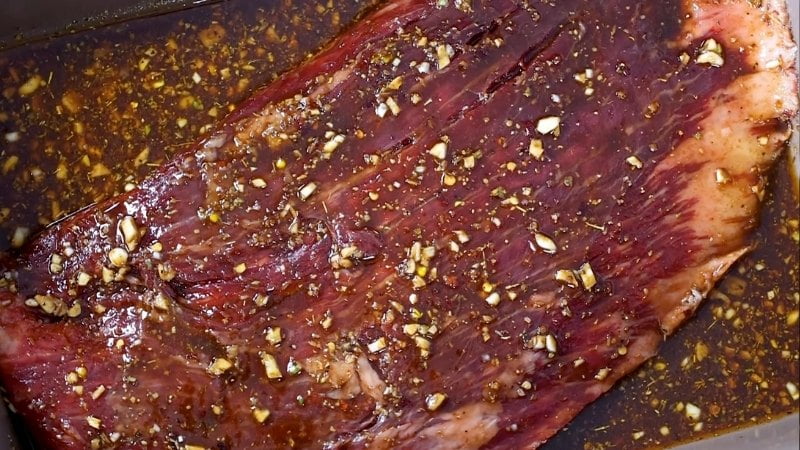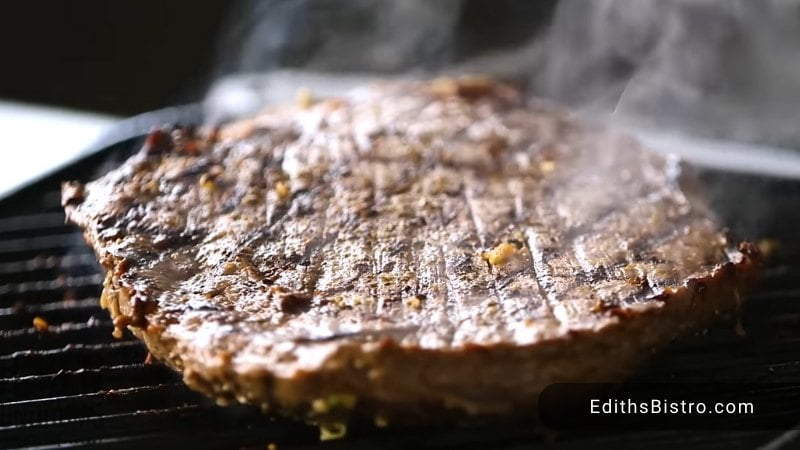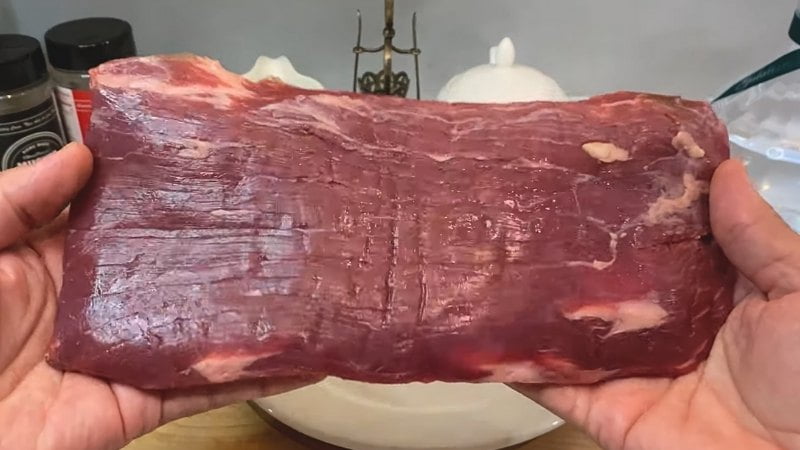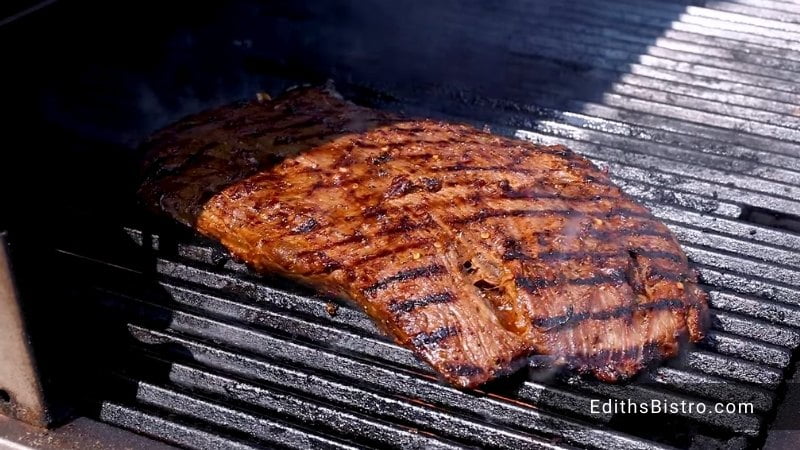Flank steak is more than just a cut of beef—it’s a culinary experience that results in a savory delight when understood and prepared correctly. This guide will journey through the intricacies of flank steak, from its definition to its preparation and everything in between.
What Is Flank Steak?
Flank steak is a lean, flat cut of beef sourced from the flank area of the cow, situated just behind the plate and in front of the rear legs. This steak is distinct due to its minimal marbling, which makes it tougher than other cuts. However, this texture gives flank steak its signature grain, making it perfect for many dishes when prepared correctly.
Flank steak has various names, depending on the context and region. It’s often referred to as “bavette” in French culinary terms. It might also be labelled as “jiffy steak” or “plank steak” in some places. It is also known as London broil, jiffy steak, arrachera, filete de falda, sobrebarriga, churrasquito de vacío, bife de vacío, bife do vazio, and pacú.
How To Marinate And Prepare Flank Steak

Marinating is essential for flank steak. Due to its lean nature, the steak can be tough. A good marinade doesn’t only impart flavor but also helps tenderize the meat.
- Preparing the marinade:
- A good marinade for flank steak typically contains acid (like citrus juice or vinegar), oil, and seasonings. The acid helps tenderize the meat, while the oil and seasonings impart flavor.
- Example Marinade: Combine 1/4 cup olive oil, 1/4 cup soy sauce, the juice of one lemon, two minced garlic cloves, two tablespoons of brown sugar or honey, and salt and pepper to taste. Feel free to add herbs like rosemary or thyme.
- Marinating the steak:
- Place the flank steak in a resealable plastic bag or a shallow dish.
- Pour the marinade over the steak, ensuring it’s fully covered.
- Seal the bag or cover the dish, and refrigerate for at least 2 hours, preferably overnight. Remember to turn the steak occasionally to ensure it is even marinating.
- Preparing for Cooking:
- Remove the steak from the refrigerator at least 30 minutes before cooking to let it come to room temperature. This ensures even cooking.
- Once marinated, pat the steak dry before cooking. This ensures a good sear, locking in all the flavorful juices.
Flank Steak Grilling Techniques

Grilling is a favored method for flank steak, imparting a smoky aroma and ensuring the meat remains juicy inside. Grilling flank steak requires attention to technique to ensure the best texture and flavor. Here are some key grilling techniques for flank steak:
- Preheat: Preheat your grill to a high temperature before placing the steak on it.
- Clean and Oil the Grates: Clean grill grates and lightly oil the grates using a cloth or paper towel dipped in cooking oil. This further ensures the steak doesn’t stick.
- Grilling:
- Due to its relative thinness, flank steak cooks quickly.
- Grill the steak for about 4-6 minutes on each side for medium-rare. Adjust the time based on your preferred doneness. A meat thermometer can help: aim for 130°F (54°C) for medium-rare.
- Use tongs or a spatula to flip the steak. Avoid using a fork, as piercing the meat can let out flavorful juices.
- If grilling multiple pieces, ensure they’re spaced adequately. Overcrowding can reduce the grill’s temperature and prevent proper searing.
- Slicing:
- Once off the grill, let the steak rest for about 10 minutes. This allows juices to be redistributed, ensuring a juicy steak upon slicing.
- Look for the direction of the muscle fibers in the meat; this is the “grain”. Slice against the grain. This ensures the meat is as tender as possible.
By following these grilling techniques, you’ll ensure that your flank steak is perfectly cooked, boasting a savory crust on the outside and a tender, juicy inside.
How To Spot The Best Flank Steak

When shopping for flank steak, ensuring you select a high-quality piece can make all the difference in your final dish. Here’s a concise guide on how to spot the best flank steak:
- Color: Look for a steak with a bright, cherry-red hue. Avoid those with a dull or overly dark color, which might indicate age or poor storage.
- Freshness: The steak should have a clean, meaty aroma. Any off-putting or sour smells indicate that the meat isn’t fresh.
- Surface texture: The meat should be moist but not excessively wet. It might be past its prime and may not be of the best quality.
- Packaging: If buying pre-packaged flank steak, ensure the packaging is tight with no punctures or excessive air. Also, the liquid (or purge) should be minimal in the package.
Tips And Tricks To Ensure Flavorful And Tender Results
- Using ingredients like citrus or vinegar in your marinade can help tenderize the meat.
- Allow the steak to sit out for 30 minutes before cooking to ensure even cooking.
- Patting the steak dry before grilling helps achieve a better sear and reduces potential flare-ups.
- Cooking at high heat can lock in juices and create a flavorful crust on the steak.
- Always slice the steak against the muscle fibres to ensure maximum tenderness.
- Aim to cook the steak to a medium-rare to medium level of doneness for best results.
- After grilling, let the steak rest for about 10 minutes to allow the juices to redistribute.
- Cut the steak into thin slices to enhance its tenderness and flavor when serving.

Storing And Freezing: Way To Preserve Flank Steak’s Freshness
Proper storage and freezing are essential to preserving the freshness of flank steak. For short-term storage, refrigerate the steak on the lowest shelf in its original packaging, ensuring it’s tightly sealed to avoid being affected by other foods. If you intend to store it for longer periods, freezing is recommended.
- Before freezing, wrap the steak securely in plastic wrap, then encase it in aluminum foil or place it in a vacuum-sealed bag to prevent freezer burn.
- Always label the package with the freezing date for reference.
- To maintain its quality, when you’re ready to use the steak, allow it to thaw gradually in the refrigerator for about 24 hours before cooking. This method ensures that the meat remains flavorful for consumption.
References:
- Wikipedia – Flank Steak – https://en.wikipedia.org/wiki/Flank_steak






![What To Pair With Quiche? 25+ Best Dishes [With Pictures]](https://www.edithsbistro.com/wp-content/uploads/2024/04/what-to-pair-with-quiche-160x90.jpg)
